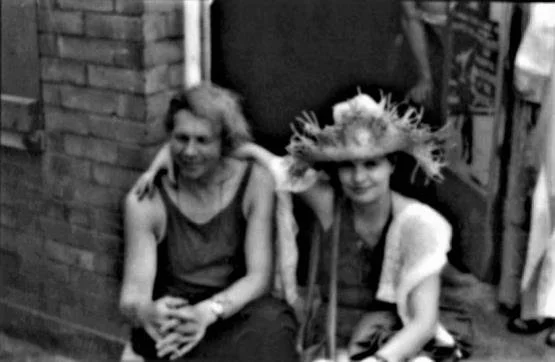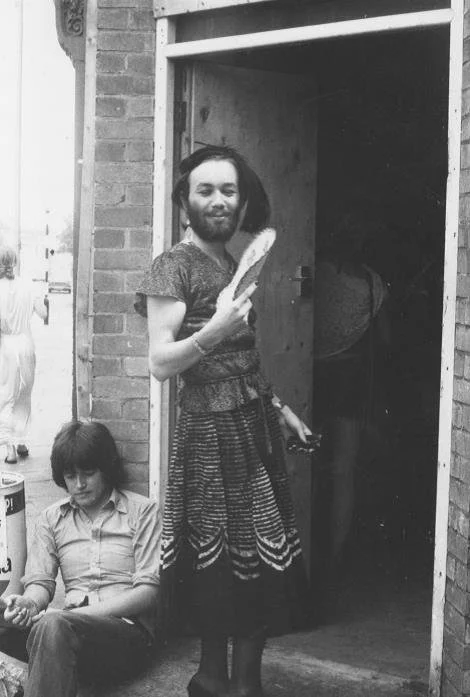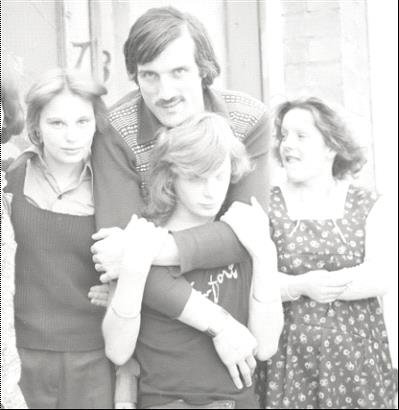With all the pomp, solemnity and detailed precision of court proceedings affidavits were submitted on behalf of the Plaintiff, Rose Silverstone (widow), the owner of numbers 78 and 80 Railton Road in which the South London Gay Community Centre and the Women's Place were squatting and Gary de Vere (male) and Ellen Jones (female) were the defendants of the former and latter. Not clear why their marital status and genders had to be declared(!) The hearing took place in the High Court of Justice Queen's Bench Division in 1975. I will summarise the plaintiff's case against occupation by the SLGCC and Gary de Vere's defence.
The Plaintiff's case (summary)
The building at 78 Railton Road had been vacated without notice in 1973 with rent arrears owing by a solicitor who had been struck off the roll of solicitors in June of that year. He had sub-let the top floor to a Nursing Agency with the rest of the building remaining unoccupied. Having not paid rent since1973 the plaintiff argued that amounted to 'surrender of the lease by operation of law'.
The plaintiff was adamant that she had not given permission for anyone to occupy any part of the building but was unable to identify the occupiers other than Mr. Oroloba, the owner of the Nursing Agency.
In 1973 an estate agent was engaged to either sell the property or find new tenants. According to the plaintiff Lambeth Borough Council had expressed an interest in purchasing the property but insisted that no serious negotiations could be entered into until vacant possession of the building had been secured.
Despite being unable to identify most of the occupiers the plaintiff cited the affidavit by William Ernest Crew who had visited both the gay centre and the Women's Place in June 1975 to ascertain the identity of those occupying the premises arguing that all reasonable steps had been taken to do this despite them not being named in the summons
The plaintiff once again reiterated that she had given no license or consent to anyone to occupy the premises and therefore claimed entitlement to possession thereof!
Opposition from Brixton Gay Community and allies to bailiffs and the police during the eviction
The Defendant's case (summary)
Gary de Vere for the SLGCC made it clear that number 78 Railton Road, like many other buildings in the vicinity, was unlikely to be of commercial value given the run down state of the area which was under a compulsory Purchase order and suffering from 'planning blight' with many buildings and houses left empty. This meant that the buildings would remain 'untenanted and useless' for years until bought by the council for demolition. The implication being that the Gay Community were putting the place to good use by occupying it and providing a service.
The gay centre was squatted in March 1974 and within a week or two was visited by one of the plaintiff's agents. Though aware of the occupation no objections were raised by the plaintiff for over a year after the building was first squatted. This led the people using the place to believe that it was 'reasonable to assume' that a license had been granted by acquiescence if not by direct consent.
To reinforce the argument the defendant pointed out that at no time during the first 15 months of existence had they been approached by the plaintiff for repossession and conceded that had it been within the first week or so they would have considered vacating the premises.
The defendant challenged the understanding that Lambeth Council would not purchase the property from the plaintiff without vacant possession and that those already in occupation of the premises could not be viewed as legitimate tenants. This was contradicted by the fact that Mr. Oroloba was already paying rent to the council as a bona fide tenant (?) and that Lambeth Council was willing to purchase the property without vacant possession pending the outcome of the SLGCC's application for a grant to cover rent and other expenses. If the grant was approved the occupants would be offered a tenancy provided they signed a rental agreement and the council would purchase the property tenants without the need for eviction proceedings to occur. The plaintiff was fully aware of these negotiations. While this matter was slowly going forward for over a period of 6 months, the defendant argued, there was no communication from the owners of the property. This again indicated the lack of interest in pursuing repossession. The defendant later also requested that the case be dismissed on the grounds of legal errors and factual inaccuracies.
Workmen boarding up the South London Gay Community Centre after the eviction with a gormless looking copper keeping guard.
The Women’s Place, one of three Women’s Centres on Railton Road, was next door to the Gay Centre and evicted on the same day.
The Lackadaisical and Questionable manner of finding and naming the occupants (a comic interlude)
For a landlord to secure court proceedings against unauthorised tenants it was necessary to discover the names of the occupiers. William Ernest Crew and colleague Dennis Victor Harley Evans, both 'enquiry agents' hired by the plaintiff's solicitors, attempted to discover the names of the people at 78 Railton Road. As attested to in their affidavits both visited the premises and the Women's Place at number 80 on several occasions in the early and late afternoons when the buildings were closed despite clear notices stating the gay centre's opening time was 7pm. Reading the affidavit from Crew it is clear he was more interested in gossipy hear say than facts from the people he spoke to in the neighbourhood. Peering through windows and letter boxes he displayed an interest in the 'shabby' appearance of the places and the political content of posters and notice boards possibly gambling on influencing a 'conservative' court hearing into prejudging the occupants to secure a conviction. Here are some of the observations made my Crew first about the gay centre and then about the Women's Place:
“....I was able to see through the window that the interior of the shop(sic) contained old armchairs and what appeared to be a rough home made counter/bar. There were posters on the walls....and plastered on the window advertising various political campaigns, protest marches and so on....The facia board had roughly painted on it "Gay Community Centre". There were also a number of posters of "The Gay Liberation Movement" which were posted on the inside of the shop front facing outwards."
He and his side kick gained access to the rooms above the gay centre and spoke to the Nursing Agency owner who informed him that the ground floor premises "were run as a homosexual Community Centre by a man called Gary de Vere and that he had the keys to the shop and to the rooms on the first floor."
This secured for them a 'name' that was necessary for a court summons and on their third visit to the gay centre, this time in the evening when it was open, all the people present refused to give their names and insisted on being addressed as a 'group'. The interloper on asking to speak to Gary de Vere was informed that he was not there.
Here are his observations on visiting the Women's Place at 80 Railton Road. Again stated in his affidavit to the court:
"The shop(sic) was locked and unoccupied but through the shop front we could see that the shop area was empty apart from a chair or two, but in the back room we could see a desk with a telephone.... there were a number of posters pasted on to the inside of the shop fronts facing out of which a selection are as follows:
1. "You know one homosexual or two or three, why hide it?"
2. "Equal Pay. Women work a seven day week."
3. "Fight the proposed anti-Abortion bill."
4. "Housing for all - thousands of homeless and no hope on waiting lists. 1000,000 empty houses in Londn. GLC (Greater London Council) evicts squatters, smashes houses leaving them empty - no evictions - all london Squatters. GLC Action Group. Advisory Service for Squatters, 44 Nelson Street, London SE1 01-261-1477."
5. "Sexism in Art." Free slide lecture and discussion, Thursday 22nd May at 8pm, Gay Community Centre, 78 Railton Road, London SE24."
6. "Come in for coffee, South London Gay Community Centre, open every night 274-7921."
7. "Quite the Common Market - 'The Morning Star'."
On his second visit to the Women's Place (closed) he questioned local shopkeepers who told him that:
"...the premises were being run by a woman called Ellen Jones who was apparently running a Lesbian Organisation. I was informed that there were about 20 women or girls who stayed at the premises from time to time but there was a constantly shifting population. There were complaints that the premises caused a great deal of noise and inconvenience to local residents and that parties went on there until the early hours of the morning."
None of this was true and a far cry from the centre's function as a women's refuge, advice centre, playgroup and HQ for the National Abortion Campaign.
Lambeth Council rejected the application for a grant and the court case for the gay centre was lost as was the case for the Women's Place. Eviction orders were granted against both organisations.
Informed by friendly supporters at Lambeth Council, who were aware of the progress of court proceedings, it became clear after the granting of a re-possession order against the gay centre that the police and bailiffs would arrive in a fairly short time to evict the 'unauthorised' tenants. Anticipating their arrival some of the contents of the centre were removed and stored in gay squats on Railton Road.
The enforcers of the eviction order were met by an angry crowd though there were no attempts to occupy the building or prevent workmen from boarding up the premises. Only token opposition was given in the full knowledge that once the building has been sealed up the place would be re-squatted on the following day. The police took an easy turn around the premises with nothing more pressing to do than to stand at the front door and chat amiably to each other or peer into the distance wondering why they were there in the first place. Normally a street disorder or mini riot was the expected by the police during evictions or aids on homes and shebeens but this proved to be something of an anti-climax. On the day of the eviction, after the place had been nailed shut, a message was scribbled in black ink on the new chipboard rigidly hammered into place forbidding entrance to the building. The message stated that the gay centre had temporarily moved to the women’s centre at 207 Railton Road.
Next day the gay liberationists approached the impregnable fortress as planned, jemmied boards loose, changed the locks and moved themselves and everything else back into the gay centre. New seating was built in the front rooms and the tired, sagging walls were livened up with fresh coats of paint. The bailiff and the council workmen had left behind the added bonus of brand new wood to tightly secure the windows and doors against future attacks from hostile forces. An open day for members of the public offering tea, coffee and cakes was organised to celebrate re-opening the South London Gay Community Centre with a fresh new start.
click on the arrows to scroll through the images below
The gay centre flourished as a social and political centre for the first 18 months then staggered on in fits and starts before its closure after about two years. Despite the threadbare organisation and a leadership oscillating between laissez faire libertarianism and hyper critical dogmatism a number of achievements can be racked up. Apart from the functions already mentioned activists at the gay centre were also responsible for setting up the 1976 Gay Pride Week event jointly with the Campaign for Homosexual Equality. They also participated in and organised many other political and social events. But the main legacy left behind by the gay centre was as a focal point in drawing other gay people (mostly men) into the area. With the continuing growth of gay squats on Railton and Mayall Roads there was a gradual shift in locus from the declining influence and eventual closure of the gay centre to the houses as the hub of social and political activity.
The refusal of a grant by Lambeth Council to cover running costs and the continuation of inadequate sources of funding through donations, dances and discos partly contributed to the gay centre's decline and closure. But more seriously was the debilitating arguments between the centre's organisers and their critics which led finally to the withdrawal of the most experienced and committed volunteers. The so-called ‘coup’ (see Gay News) was the result of irreconcilable differences and persistent infighting between those centre users who were described as 'nerds', 'druggies', 'untogether', 'disruptive elements' by their detractors and the more educated 'hierarchy' of organisers, movers and shakers who were seen as ‘elitist’. This was characterised by some as antagonism between working class users and middle class 'student types' who were seen as the ‘collective’ hierarchy and too rigidly dogmatic in their political stance against bisexuals and heterosexuals using the centre.
But the last few months of life under the new regime, with the absence of motivation and organisational skills, the gay centre went to rack and ruin with unpaid bills, lack of maintenance and an increasingly unwelcoming atmosphere of drunkenness and drug use. The residual users of the centre had also turned against it being exclusively for gay people with straight couples using it as a bolt hole for sexual liaisons.
The 'untogether' people who 'seized' control of the gay centre which led to its neglect and demise. Photographs for 'bloodless coup': Robert Workman archive, Bishopsgate Institute
With little or no interest in keeping the centre on an even keel it rapidly fell into decay until finally the building was abandoned and later demolished. Both the gay centre and the Women’s Place next door were buried under slabs of paving stone and are now a forecourt for St. George’s Residences.
The gay centre was a welcome haven for some and weathered the initial storms of hostility in the middle of a poor, working class, inner city area with high levels of poverty, racism, crime and unemployment. What the gay centre did achieve was a breathing space that allowed a considerable number of people the opportunity of breaking away from an isolated and confused existence into something approaching the self-confidence, self-worth and integrity needed to fight back against the burden of an essentially hostile world. Not to put too fine a point on it there was also a lot of fun, hilarity and laughter on our way to carving out a 'liberated' space for ourselves.
The collective coming together of mostly gay men released an enormous amount of creativity right across the board. The gay centre and squats encouraged, in a communal setting, the astonishing growth of artists, writers, sculptors, actors, technicians, musicians and political activists. It is inconceivable that the creative talents that went into all the Brixton Faeries theatre productions or the campaigns around gay pride and Gay News or the spirited energy and commitment that encouraged many people to came out loud and proud could have happened had people remained isolated in their bedsits, flats or rooms in a shared house.
It was a limited achievement which ultimately failed as a ‘Utopian’ experiment in communal living. Nevertheless that achievement to this day still raises affectionate memories in those who continue to challenge the smugness and complacency of a decaying capitalist system as we enter the third decade of a globally disastrous and nightmarish century. We can learn lessons of real and lasting value from those experiences of past endeavours as the struggle for gay liberation continues especially the need to build and maintain a collective identity in struggle with others against the worsening system of exploitation and oppression that is capitalist patriarchy. The value of solidarity and community against atomisation and isolation can never been underestimated in the continuing battle for liberation and that’s the lesson we can learn from those 1970s experiments in collective living, loving, campaigning and creative artistic endeavours.








































